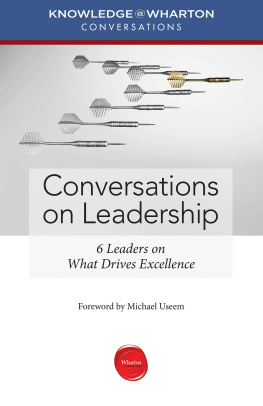Contents
Guide
Pagebreaks of the print version
Praise for the first edition of The Strategic Leaders Roadmap
Thinking strategically and acting decisively are vital capabilities for running any enterprise, and the Wharton Schools Harbir Singh and Michael Useem show how to develop and apply them together. The Strategic Leaders Roadmap offers an invaluable model for the strategic leadership required at all levels in any organization during the turbulent era ahead.
Ajay Banga, Executive Chairman, MasterCard Inc.
The Strategic Leaders Roadmap provides an essential playbook for combining business strategy with great leadership. In an era of heightened change and uncertainty, the exercise of both has become essential, and Harbir Singh and Michael Useem offer managers and executives compelling illustrations and practical guidance for doing so.
William P. Lauder, Executive Chairman, The Este Lauder Companies Inc.
For pragmatic direction on how best to combine a companys strategy and its leadership, The Strategic Leaders Roadmap is essential reading. Harbir Singh and Michael Useem have brought executive experience together with university research to identify the essential steps for the art of leading strategically.
Maggie Wilderotter, former Chairman and CEO, Frontier Communications; director, Costco, DreamWorks Animation, Hewlett Packard Enterprise, and Juno Therapeutics

2021, 2016 by Harbir Singh and Michael Useem
Published by Wharton School Press
The Wharton School
University of Pennsylvania
3620 Locust Walk
300 Steinberg Hall-Dietrich Hall
Philadelphia, PA 19104
Email:
Website: wsp.wharton.upenn.edu/
All rights reserved. No part of this book may be reproduced, in any form or by any means, without written permission of the publisher. Company and product names mentioned herein are the trademarks or registered trademarks of their respective owners.
Ebook ISBN: 978-1-61363-120-1
Paperback ISBN: 978-1-61363-121-8
Hardcover ISBN: 978-1-61363-152-2
Contents
Introduction
Strategic Leadership as the Driver of Growth and Renewal
O ne of those light bulb moments happened when Apple cofounder Steve Jobs visited a Xerox lab in Silicon Valley in 1979. He learned of an experimental mouse and cursor for scrolling and clicking through menus and icons on a computer display. Xerox never commercialized the mouse and cursor, but Jobss glance was enough for him to instantly appreciate the devices enormous potential for navigating computer interfaces.
When Apple introduced Lisa in 1983, the first personal computer equipped with a cursor and mouse, the New York Times explained with wonder what would soon become commonplace for us all: The mouse moves, and the cursorthe arrow that points to particular places on the screenmoves accordingly. A year later, Apple added its mover and pointer to its new personal computer, the Macintosh, helping it become a runaway success, canonizing the interface devices, and launching the company on its way to the stratosphere. Apples market value touched $2 trillion in 2020, the first US company to do so.
Garrett Camp had experienced his own flash of insight when wondering how to reduce the cost of using black-car services, taxis dispatched rather than hailed on the street. After he and his friends had spent hundreds of dollars on rides, it dawned on him that they might cut their costs if they could somehow share the car services with others. Camp and Travis Kalanick created the ride-sharing company Uber to do just that, combining the smartphone, geolocation, and network communication. Kalanick took the helm of Uber in 2010 and soon transformed the fledgling start-up into a global behemoth.
While Steve Jobs and successor Tim Cook successfully converted Jobss insights into Americas most valued enterprise, Kalanicks leadership of Uber by contrast proved toxic. Ubers directors forced Kalanick out in 2017, believing their burgeoning business required far better hands on the tiller if its groundbreaking strategy was actually to generate growth.
If a sailing ship without a qualified skipper is sure to flounder, it seems likely that a promising business model without a competent chief would suffer the same fate. And that is the thrust of what we advocate here: Good strategy and good leadership are equally essential for building a firm. They are two sides of the company coin, each different but both completely dependent on the other, the yin and yang of the enterprise.
Consider the strategy and leadership of Tricia Griffith, who joined the Progressive Corporation, a provider of auto and property insurance for millions, fresh out of college. She started in Indianapolis as a claims-representative trainee for auto damage, rotated up the ranks through a host of other functions, and reached the corner office in 2016.
Griffith espoused a strategy of fast expansion, and under her leadership the company grew more than 20% annually, adding 8,400 new employees in 2019 alone. Progressives net new premiums had jumped by 50% during her first three years as chief executive, pushing it to overtake Allstate as Americas third-largest auto insurer after State Farm and Geico, and catapulting it onto the Fortune 100. Fortune magazine named Griffith Businessperson of the Year in 2020, and its headline for the best among the Fortune 500 asked readers to meet the CEO of the insurance company growing faster than Apple.
While Griffith had locked onto a strategy of aggressive growth, her personal style brought that strategy to life through a deft combination of presence, inclusion, and direction that let her personally energize but also focus the front lines. She described herself as being out and about as much as possible, and she pressed direct reports to do the same. The head of a company of 40,000 people, she nonetheless stopped to greet and swap the latest with just about everybody she encountered, some at their desks and others in the hallways. I never take the elevator, she noted.
During one event to welcome new employees in 2019, a woman recruited from an archrival told how in the twelve years at her previous employer she had never met her bosss boss, let alone the chief executive. On meeting Griffith now, the newcomer was initially intimidated, but the CEO soon had her talking. People feel like Im the girl next door, Griffith explained.
Rather than boldly striding to the front of the welcome event as a deferential hush descended on the hundreds waiting to see the big boss, Griffith worked the room, shaking hands and greeting everyone along her path, brushing past no one. And then, without a stage, riser, or lectern, she began speaking, appearing both personal and professional.
Griffith began her welcome with reference to her own college, Illinois State University, located coincidentally in the same town as archrival State Farm Insurance. The school was not the Ivy League, but it was solidU.S. News & World Report ranked ISU 197th among 399 national universities in 2019and that was partly her point. Like so many in the room, Griffith had credentials that reflected Middle America, and she stood with the newcomers, not above them. Her first job at Progressive, crawling under damaged cars and talking with injured customers, was hardly a fast-track entry point. The company itself was such an unknown quantity that when Griffith told her mother she was joining Progressive, her mother asked, Oh, the soup company?











